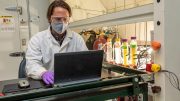
Researchers have found a way to accelerate the formation of carbon dioxide-based crystal structures, which could potentially store billions of tons of carbon under the ocean floor for centuries or longer.
- Capturing and burying carbon is one of the most promising ways to blunt the pace of climate change
- University of Texas and ExxonMobil researchers found a way to speed up the formation of crystal structures called hydrates that can store billions of tons of carbon for centuries
- Adding magnesium to the reaction led to a 3,000x increase in hydrate formation wait time — from hours or even days down to a few minutes
There’s a global race to reduce the amount of harmful gases in our atmosphere to slow down the pace of climate change, and one way to do that is through carbon capture and sequestration — sucking carbon out of the air and burying it. At this point, however, we’re capturing only a fraction of the carbon needed to make any kind of dent in climate change.
Researchers from The University of Texas at Austin, in partnership with ExxonMobil, have made a new discovery that may go a long way in changing that. They have found a way to supercharge the formation of carbon dioxide-based crystal structures that could someday store billions of tons of carbon under the ocean floor for centuries, if not forever.
“I consider carbon capture as insurance for the planet,” said Vaibhav Bahadur (VB), an associate professor in the Cockrell School of Engineering’s Walker Department of Mechanical Engineering and the lead author of a new paper on the research in ACS Sustainable Chemistry & Engineering. “It’s not enough anymore to be carbon neutral, we need to be carbon negative to undo damage that has been done to the environment over the past several decades.”
These structures, known as hydrates, form when carbon dioxide is mixed with water at high pressure and low temperature. The water molecules re-orient themselves and act as cages that trap CO2 molecules.
But the process initiates very slowly – it can take hours or even days to get the reaction started. The research team found that by adding magnesium to the reaction, hydrates formed 3,000 times faster than the quickest method in use today, as rapidly as one minute. This is the fastest hydrate formation pace ever documented.
“The state-of-the-art method today is to use chemicals to promote the reaction,” Bahadur said. “It works, but it’s slower, and these chemicals are expensive and not environmentally friendly.”
The hydrates form in reactors. In practice, these reactors could be deployed to the ocean floor. Using existing carbon capture technology, CO2 would be plucked from the air and taken to the underwater reactors where the hydrates would grow. The stability of these hydrates reduces the threat of leaks present in other methods of carbon storage, such as injecting it as a gas into abandoned gas wells.
Figuring out how to reduce carbon in the atmosphere is about as big of a problem as there is in the world right now. And yet, Bahadur says, there are only a few research groups in the world looking at CO2 hydrates as a potential carbon storage option.
“We are only capturing about half of a percent of the amount of carbon that we’ll need to by 2050,” Bahadur said. “This tells me there is plenty of room for more options in the bucket of technologies to capture and store carbon.”
Bahadur has been working on hydrate research since he arrived at UT Austin in 2013. This project is part of a research partnership between ExxonMobil and the Energy Institute at UT Austin.
The researchers and ExxonMobil have filed a patent application to commercialize their discovery. Up next, they plan to tackle issues of efficiency — increasing the amount of CO2 that is converted into hydrates during the reaction — and establishing continuous production of hydrates.
Reference: “Magnesium-Promoted Rapid Nucleation of Carbon Dioxide Hydrates” by Aritra Kar, Palash Vadiraj Acharya, Awan Bhati, Ashish Mhadeshwar, Pradeep Venkataraman, Timothy A. Barckholtz, Hugo Celio, Filippo Mangolini and Vaibhav Bahadur, 11 August 2021, ACS Sustainable Chemistry & Engineering.
DOI: 10.1021/acssuschemeng.1c03041
The research was funded by ExxonMobil and a grant from the National Science Foundation. Bahadur led the team, which also includes Filippo Mangolini, an assistant professor in the Walker Department of Mechanical Engineering. Other team members include: from the Walker Department of Mechanical Engineering Aritra Kar, Palash Vadiraj Acharya and Awan Bhati; from Texas Materials Institute at UT Austin Hugo Celio and researchers from ExxonMobil.









Just for clarification, shouldn’t that be a 3,000x DEcrease in hydrate formation wait time?
“… carbon dioxide-based crystal structures that could someday store billions of tons of carbon under the ocean floor for centuries, if not forever.”
NOTHING is forever — not even diamonds! “Diamonds are forever” may make a good marketing slogan, but it isn’t very scientific.
the irony of exxon trying to develop technology that lets them continue their existing business of producing atmospheric carbon 😂
Actually, if humans didn’t use their products that give us our wonderful lifestyles and high standard of living they wouldn’t have any reason to exist. The don’t produce atmospheric CO2, we do. Even biofuels are 95% fossil fuel and only 10% plant derived ethanol.
“We are only capturing about half of a percent of the amount of carbon that we’ll need to by 2050.”
That 0.5% is the amount that was added last year…about 38 million tons. The IEA estimates that 7600 million tons will be needed by 2050 to “make a dent” in the amounts we have already added. The problem? 7600 is not even ONE part-per-million. If actually captured and stored the climate would not even notice it. All of these plans to store CO2 somewhere are a waste of time and lots of money to wind up with nothing in the end.
C02 is thought to be the major problem, but it’s actually heating that is the major problem (right now). IF C02 could be reduced SIGNIFICANTLY it would certainly help, but it would take hundreds of years to do that, and we do not have that kind of time. What really needs to be done is to reduce global temperatures FIRST. There is only one known way that this could be done swiftly (MEERS project). Get this up and scaled now, while also working on carbon capture technologies and methods. If we just focus on lowering C02 we are definitely going to fail because temperatures are increase WAY too fast.
Most publications and papers are using an incorrect pre-industrial baseline temperature graphs (and future estimates), it should be 1750 in ALL projections, but you will see 1850 and even 1908 and similiar, which make it appear we’ve only warmed 1.1C or thereabouts. Not true – actual warming is well over 1.5C right now, making it impossible to meet the so-called “targets”. We are fast approaching 2C which is where biological thermal maximums begin (species deaths) and at 3C – human deaths en mass. At 4C all plant life will likely be extinct that we depend upon for food crops. Current emissions trajectory is 8.5C which is very, very bad, but it is temperatures that must be reduced FIRST. This is the only thing that will give humanity a fighting chance at survival and the rest of the biosphere. More importantly it is something we can actually do right now, the technology already exists.